








If you should find yourself at a loss for world-changing ideas, know that you're only a click away. Check out TED Talks and Pop!Tech Pop!Casts to get schooled and inspired by the greatest thinkers sharing their greatest thoughts.
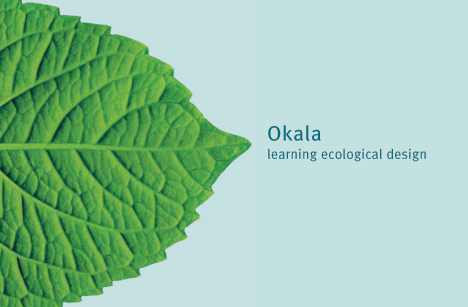
Green is the new black when it comes to student design, but if we see one more "green" bamboo plywood coffee table or "sustainable" mirror made from CDs we'll vomit...or explode...or maybe even both at the same time. There's nothing wrong at all with going green—in fact, it's downright commendable as long as you don't take the easy way out (CD mirror). It's no simple feat, but you're not without help. The iDSA has recently published the Okala (hopi for "life sustaining energy") Design Guide for 2007, an intro to sustainable design for practicing and beginning designers. Pick the best morsels that inspire you to launch your ecologically responsible concepts with some real substance. Follow through with solid research and a logical application—a sophisticated, well thought-out concept in theory kicks way more ass than a, um, CD mirror.
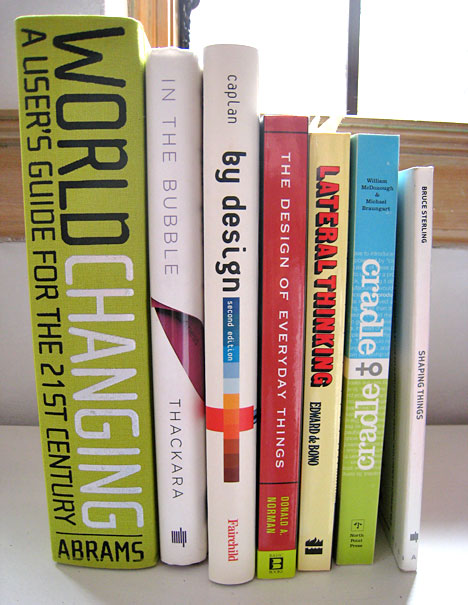
There are a ton of great design books out there, and it's near impossible to boil them down to 7, but if you've only got the money or the shelf space for a baker's half-dozen, make them these:
Worldchanging
by Alex Steffen
In the Bubble
by John Thackara
By Design
by Ralph Caplan
The Design of Everyday Things
by Donald Norman
Lateral Thinking: Creativity Step by Step
by Edward De Bono
Cradle to Cradle
by William McDonnough and Michael Braungart
Shaping Things
by Bruce Sterling
Now go fill your shelves: Core77 Book Reviews
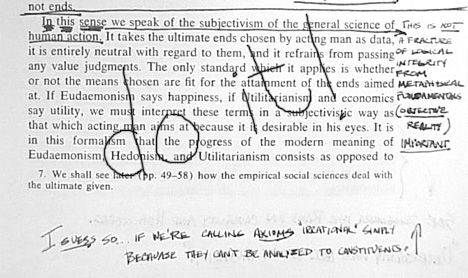
My freshman year in college I took a philosophy course from a professor who began by announcing that no textbooks would be used in his class. Plenty of books were required, however. "I want you to come out of this course with the beginnings of a good library," the professor told us, "and textbooks have no place in such a library. Nothing in the world has less value than a used textbook."
So we were not assigned any books with titles like "Introduction to Philosophy," or "Foundations of Empirical Thought," written by scholars whose training and degrees presumably qualified them to interpret what thinkers thought. The books we read were original material, the works of the thinkers themselves: Plato, Aristotle, William James, Bertrand Russell, Albert North Whitehead, Kant, Descartes...
I argued with Plato, mocked Immanuel Kant, challenged the logic of William James, talked back to Aristotle. Of course they couldn't respond; but given the stupidity and naiveté of some of my comments, that was just as well. And it offered advantages the internet can't. The satisfaction of online exchange comes at a cost: the dead can't play. Sure, you can talk to Michael Beirut and Yves Behar. But you can't reach Raymond Loewy or Norman Bel Geddes in the blogosphere.
The professor's flattering assumption was that students were smart enough to confront ideas directly. Maybe we were, but this was heady stuff and tough to go through without the organizational crutch of a textbook author. I cannot imagine getting through it at all, had the professor not provided us with a tip: "Make each book your own," he exhorted, "by annotating and footnoting and indexing it for yourself."
Continue reading Why you should write in your books. Or, Talking Back to Aristotle and Loewy by Ralph Caplan.

Manifestos can be limiting, but they can also be inspiring. Start with this one on sustainability:
Wanna be yelled at some more? Read the rest here.
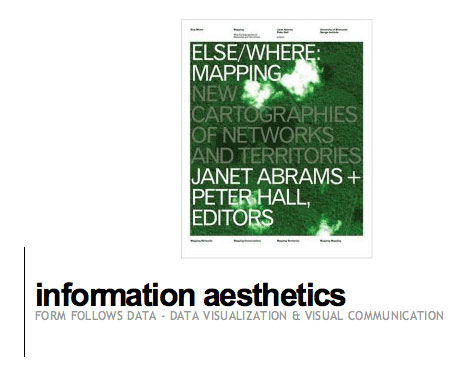
Design is part of larger systems—cultural, technological, environmental—you name it. Sometimes it's hard to get a bird's eye view of things, but fear not, there are lots of resources. One of the best books for your (new) shelves is Else/Where: Mapping New Cartographies of Networks and Territories, by Janet Abrams and Peter Hall, a wonderful book for smacking you upside the head with a left of scale and a right of context. For your bookmarks bar, there's infosthetics.com, an amazing blog highlighting some of the best in data visualization.

I have a few friends that are tragic slaves to fashion. But for me, it's more sad to see how many industrial designers are trained to be slaves to function. While both extremes may be tragic, I've always wondered why the fashion designers seem to have all the fun. Why has fashion managed to tell so many stories, and industrial design so few?
Design today is not neutral. It is biased and targeted at specific audiences based on emotional triggers that have a specific form. Don't be timid about it.
Well that may be changing as more product designers see the value of storytelling as a tool for creating form and delivering new product experiences. 'Designer as Author' is an emerging concept in education that seeks to fill this cultural void—where products are not slaves to function, where sometimes Form follows Art, where products can be ideas first and utility second, where new stories lead the market—not follow it, and where design proposals introduce alternative social values into pop culture.
Think you might have that mutant design author gene in your DNA? Then you may need some new tools. Here's six introductory tips for getting the story into the form.
Continue reading Spinning Form: How to Tell Stories with Product Design by Scott Klinker.
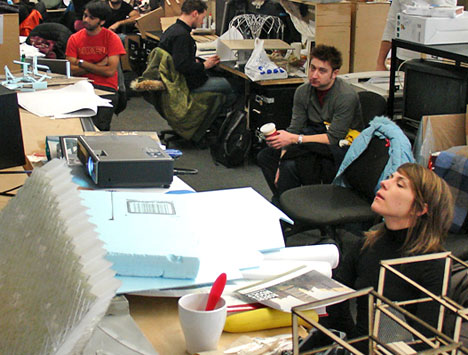
There's a torrent of talk in the news these days about 'sustainability.' And as design students, many of us spend a lot of time thinking about how to make our designs more energy efficient, healthier, and more environmentally sustainable. But amidst this onslaught of talk about sustainable design, one thing that doesn't often get mentioned is the sustainability of the atmosphere of design school.
I'm currently an architecture grad student, and despite my sincere passion for being in school, I can tell you that I've never seen a more unhealthy, more unsustainable environment than that of architecture school. How many people recognize this picture: students routinely spending 10-15 hours per day sitting in one place, glued to flickering computer screens working on 3D renderings, wedged into painfully cramped desks while toxic chemicals are mixed and handled all around them. I've often found myself in this exact position: eyes straining, back sore, trying to finish a project at 4am, under flickering fluorescent lights, while someone next to me melts acrylic with a cancer-causing chemical, the person on the other side of me hacking up toxic blue foam with a small saw, and the person behind me snoring in a sleeping bag underneath her desk. If you recognize yourself in this picture„consider this your wake-up call: THIS IS NOT HEALTHY!
Amidst this onslaught of talk about sustainable design, one thing that doesn't often get mentioned is the sustainability of the atmosphere of design school.
I frequently managed to pull multiple all-nighters in this type of environment, slowly watching more and more lines appear underneath my eyes and grey hairs popping up on my head. Why do we pay tens of thousands of dollars to subject ourselves to this kind of life, when other professional schools seem to have evolved to a more reasonable understanding of a live/work balance? Even medical schools, which used to be famous for torturing their students with grueling hours and unreasonable deadlines, have wised-up to the fact that red-eyed, sleep-deprived, pill-popping students can't learn effectively or make smart decisions. We do it because it's the culture of design school„this is what is expected of us, and what everyone around us seems to accept as 'the way things are.' This type of uber-competitive, insanely unhealthy atmosphere will only change when we decide to stop putting up with it, so the change has to start with you. And you can't fight the battle alone, so talk to your friends and teachers and try to get some support to stop the madness.
Here are 5 steps to taking back your life, and demanding a sustainable, healthy and productive experience as a design student:
continue reading
Well, don’t hang out with them all the time. It's the start of the semester, and soon you'll be engrossed in a world of blue foam, Bondo, and marker fumes. You will be eating, sleeping, working, and partying with your fellow designers 24/7. (Maybe not sleeping with them exactly, but you get the idea.) It will be very easy to get caught up in the narrow focus of design education and to not look past it. But the great thing about the world is that there are a ton of smart, interesting, and engaging people who are not industrial designers—haven't even heard of one. And if you are going to work with and design for the rest of this world, you need to go out and meet some of them.
If you are going to work with and design for the rest of this world, you need to go out and meet some of them.
Observe how these different disciplines problem solve and develop new ideas. Architects, communication designers, painters, and photographers are extremely interesting (and have good parties), but their experience and points of view might be a bit close to home. Instead, have lunch with the person down the hall who is majoring in philosophy. Who knows—you may discover that all this interaction with other disciplines becomes your own personal "allegory of the cave." Talk to business, marketing, and finance majors, since you'll be working with them a lot in the future. (You have no idea, actually.) Find a friend who is a writer or literary major, and learn how they discuss ideas and communicate stories.
Continue reading Why You Shouldn't Hang Out With Designers by Sam Montague.